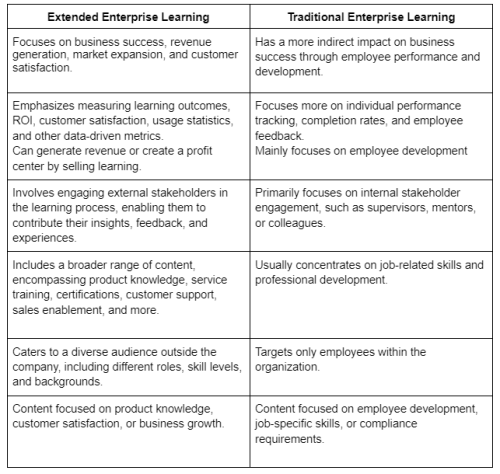This blog is Part 2 of a 3-part series. It discusses the differences in extended enterprise learning compared to traditional enterprise learning.
Defining an extended enterprise audience can have some nuances that can make it more difficult to manage than traditional enterprise learning. To start, defining the audience of extended enterprise is more complex. Extended enterprise learning includes not only the training of internal employees but also extends to external employees – such as contractors, temporary or contingent workers, consultants, partners, independent franchisees, and customers are part of the extended enterprise ecosystem. Traditional learning, on the other hand, focuses solely on the internal workforce.
The impact to the business is different for extended enterprise learning compared to traditional enterprise learning.

In a recent Brandon Hall study, these are the top challenges to delivery extended enterprise learning:
- Organizational silos
- Difficulty measuring effectiveness
- Lack of the right technology
- Content development
- Lack of insight into external groups
- Cost structures
It is important to attain the appropriate learning technology to support the vast differences of the processes. This can be done by getting a learning management system that can seamlessly manage the administrative and learner experiences accordingly. Adobe Learning Manager is an excellent solution to support these requirements.
Defining an extended enterprise audience can have some nuances that can make it more difficult to manage than traditional enterprise learning. To start, defining the audience of extended enterprise is more complex. Extended enterprise learning includes not only the training of internal employees but also extends to external employees – such as contractors, temporary or contingent workers, consultants, partners, independent franchisees, and customers are part of the extended enterprise ecosystem. Traditional learning, on the other hand, focuses solely on the internal workforce.
The impact to the business is different for extended enterprise learning compared to traditional enterprise learning.

In a recent Brandon Hall study, these are the top challenges to delivery extended enterprise learning:
- Organizational silos
- Difficulty measuring effectiveness
- Lack of the right technology
- Content development
- Lack of insight into external groups
- Cost structures
It is important to attain the appropriate learning technology to support the vast differences of the processes. This can be done by getting a learning management system that can seamlessly manage the administrative and learner experiences accordingly. Adobe Learning Manager is an excellent solution to support these requirements.
You must be logged in to post a comment.
- Most Recent
- Most Relevant






